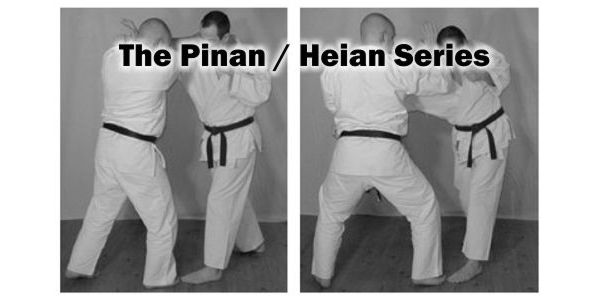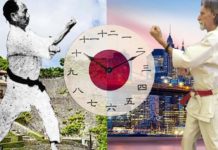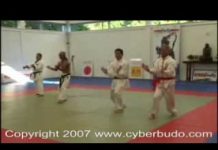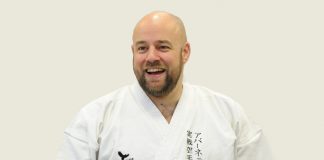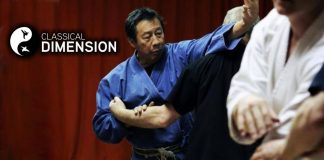Welcome to part three of this series of articles. In the first part of this series we looked at the background of the Pinan / Heian katas and discussed how they are said to represent a coherent fighting system that contains techniques for use at all stages and all ranges of a fight. We also discussed that the modern order in which the forms are taught is based upon the technical difficulty of the solo performance of the forms; whereas the original order (Pinan Shodan / Heian Nidan first) is based upon stages of a live fight. If allowed to progress, a physical altercation will generally go through a series of stages: Pre-fight (verbal exchanges, aggressive body language), limbs coming into range (strikes, attempted grabs etc), grips being established, and finally grappling.
In part one, we saw how Pinan Shodan (Heian Nidan in Shotokan) predominately deals with the initial exchange of limbs. In part two, we saw how Pinan Nidan (Heian Shodan) moves on to deal with techniques that can be applied once the initial grip has been established. In part three, we will look at what happens next and how Pinan / Heian Sandan is in fact a grappling form that deals with techniques that can be used when fighting from a clinch.
This first application we shall look at is how the first seven moves of Pinan / Heian Sandan map out an arm-lock and a takedown that flows on from an attempt to seize the throat, groin or eyes whilst fighting from a clinch.
The opponent has seized your wrist in order to prevent you from attacking their groin (Fig 1). Reach across and seize your opponent’s elbow (Fig 2). Rotate your seized arm upwards as you pull the opponent’s elbow towards you. You will recognize this motion as the first ‘block’ of the kata (Fig 3).
Straighten your legs, pull down on the opponent’s wrist and push up on their elbow. This will lock the opponent’s shoulder. This movement is the application of the simultaneous ‘lower-block’ and ‘outer-block’ (Fig 4). The kata then proceeds to map out all remaining ways in which your wrist could be seized (left, right, hand up, hand down etc). It’s a bit lengthy to explain here, but if you watch the first video in my Bunkai-Jutsu series, you can see it fully explained on there. Once the various options have been mapped out, the kata concludes the sequence with a ninety-degree turn to the front. This motion is informing us that, regardless of the initial grip, we should turn ninety-degrees, whilst continuing to rotate the opponent’s arm, in order to force the opponent onto the floor (Fig 5).
Later on in the form, we have the one-hundred and eighty degree turn with the hands being placed on the hip. We then step forward with the right foot into horse-stance and execute a ‘forearm block’. The application of this technique is a headlock followed by a cross-buttocks throw. We can again see how Pinan / Heian Sandan is a grappling form.
From the clinch shown, secure the back of the opponent’s head and push your body forwards in order to head-butt the opponent. On the head-butt, you should ensure that you hit the opponent below their eyebrows, with the area above your eyebrows (Fig 6). Keep a tight hold of the opponent’s triceps as you turn your body and feed your right arm around the back of the opponent’s neck. Pull on the opponent’s arm and pull their head in towards your body so that you secure a strong headlock. As you apply the headlock, bring your rear foot towards the opponent. This is the application of the turn where the hands are placed on the hips (Fig 7).
Step forwards with your right foot as you push your hips backward so that the left side of your hip is touching the opponent’s body. Pull the opponent in the direction of the step so that their upper-body is bent over your hip and their feet are lifted off the ground. This is the application of the step forward into horse-stance and the ‘forearm block’ (Fig 8). It is vital that you push your hips far enough back so that they block the path of the opponent’s legs. Continue to pull with the arms and push with the legs so that the opponent is taken over the back of your hips and onto the floor (Fig 9). Once the opponent’s balance has been broken you should release your grip otherwise you will end up on the floor. This release is one of the functions of the following ‘strike’.
As a grappling kata, Pinan / Heian Sandan contains a number of throws and takedowns. We shall now see how the end motion can also be applied as a throw (Fig 10). This movement is frequently labelled as a punch and elbow to the rear. However, this application does not consider the purpose of the turn and the fact that the punch will be around one foot short of the target. The step up, turn and arm motion are best applied as a hip throw. From a clinch, you should secure a grip on the opponent’s triceps and feed your other arm around the opponent’s back. The step and turn, as recorded in the kata, will correctly position you for the throw. You should then lift the opponent with your legs and move the arms as per the kata (the ‘punch’ and ‘elbow,) to throw the opponent over your hip (Fig 11).
Although it is not practical to discuss every application in Pinan Sandan in an article such as this, it is hoped that the examples that we have covered show how Pinan Sandan is indeed a grappling form. It is also hoped that you can see the logical progression in ranges as we have examined some of the applications from the first three Pinan katas. As we have seen, Pinan Shodan (Heian Nidan) predominately deals with the initial exchange of limbs; Pinan Nidan (Heian Shodan) predominately deals with the initial grip being established; and Pinan / Heian Sandan covers techniques to be used when fighting from a clinch. So what do Yodan and Godan cover?
As you may remember from part one of this series, in addition to the main progression in content that is based on the progression of a live fight, the Pinan / Heian series also includes a sub-progression based on the relative technical difficulty of the applications. Therefore, both Yodan and Godan build upon the techniques and concepts introduced in the first three forms. In general terms, Yodan introduces some more advanced techniques and ideas – including how techniques can be used in combination whilst maintaining control over the opponent – and Godan develops these ideas yet further to include yet longer combinations and transitions. We will look at some examples from Pinan / Heian Yodan in part four of this series.

